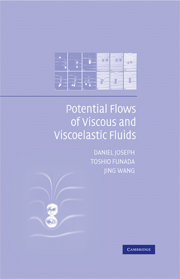Book contents
- Frontmatter
- Contents
- Preface
- List of Abbreviations
- 1 Introduction
- 2 Historical notes
- 3 Boundary conditions for viscous fluids
- 4 Helmholtz decomposition coupling rotational to irrotational flow
- 5 Harmonic functions that give rise to vorticity
- 6 Radial motions of a spherical gas bubble in a viscous liquid
- 7 Rise velocity of a spherical cap bubble
- 8 Ellipsoidal model of the rise of a Taylor bubble in a round tube
- 9 Rayleigh–Taylor instability of viscous fluids
- 10 The force on a cylinder near a wall in viscous potential flows
- 11 Kelvin–Helmholtz instability
- 12 Energy equation for irrotational theories of gas–liquid flow: viscous potential flow, viscous potential flow with pressure correction, and dissipation method
- 13 Rising bubbles
- 14 Purely irrotational theories of the effect of viscosity on the decay of waves
- 15 Irrotational Faraday waves on a viscous fluid
- 16 Stability of a liquid jet into incompressible gases and liquids
- 17 Stress-induced cavitation
- 18 Viscous effects of the irrotational flow outside boundary layers on rigid solids
- 19 Irrotational flows that satisfy the compressible Navier–Stokes equations
- 20 Irrotational flows of viscoelastic fluids
- 21 Purely irrotational theories of stability of viscoelastic fluids
- 22 Numerical methods for irrotational flows of viscous fluid
- Appendix A Equations of motion and strain rates for rotational and irrotational flow in Cartesian, cylindrical, and spherical coordinates
- Appendix B List of frequently used symbols and concepts
- References
- Index
16 - Stability of a liquid jet into incompressible gases and liquids
Published online by Cambridge University Press: 09 October 2009
- Frontmatter
- Contents
- Preface
- List of Abbreviations
- 1 Introduction
- 2 Historical notes
- 3 Boundary conditions for viscous fluids
- 4 Helmholtz decomposition coupling rotational to irrotational flow
- 5 Harmonic functions that give rise to vorticity
- 6 Radial motions of a spherical gas bubble in a viscous liquid
- 7 Rise velocity of a spherical cap bubble
- 8 Ellipsoidal model of the rise of a Taylor bubble in a round tube
- 9 Rayleigh–Taylor instability of viscous fluids
- 10 The force on a cylinder near a wall in viscous potential flows
- 11 Kelvin–Helmholtz instability
- 12 Energy equation for irrotational theories of gas–liquid flow: viscous potential flow, viscous potential flow with pressure correction, and dissipation method
- 13 Rising bubbles
- 14 Purely irrotational theories of the effect of viscosity on the decay of waves
- 15 Irrotational Faraday waves on a viscous fluid
- 16 Stability of a liquid jet into incompressible gases and liquids
- 17 Stress-induced cavitation
- 18 Viscous effects of the irrotational flow outside boundary layers on rigid solids
- 19 Irrotational flows that satisfy the compressible Navier–Stokes equations
- 20 Irrotational flows of viscoelastic fluids
- 21 Purely irrotational theories of stability of viscoelastic fluids
- 22 Numerical methods for irrotational flows of viscous fluid
- Appendix A Equations of motion and strain rates for rotational and irrotational flow in Cartesian, cylindrical, and spherical coordinates
- Appendix B List of frequently used symbols and concepts
- References
- Index
Summary
In this chapter we carry out an analysis of the stability of a liquid jet into a gas or another fluid by using VPF. This instability may be driven by KH instability that is due to a velocity difference and a neck-down that is due to capillary instability. KH instabilities are driven by pressures generated by a dynamically active ambient flow, gas or liquid. On the other hand, capillary instability can occur in a vacuum; the ambient can be neglected. KH instability is included by a discontinuity of the velocity at a two-fluid interface. This discontinuity is inconsistent with the no-slip condition for Navier–Stokes studies of viscous fluids, but is consistent with the theory of potential flow of a viscous fluid. We start our study with an analysis of capillary instability.
Capillary instability of a liquid cylinder in another fluid
The study of this problem is especially valuable because it can be solved exactly and was solved by Tomotika (1935). This solution allows one to compute the effects of vorticity generated by the no-slip condition. The ES can be compared with irrotational solutions of the same problem. One effect of viscosity on the irrotational motion may be introduced by evaluation of the viscous normal stress at the liquid–liquid interface on the irrotational motions.
- Type
- Chapter
- Information
- Potential Flows of Viscous and Viscoelastic Liquids , pp. 215 - 271Publisher: Cambridge University PressPrint publication year: 2007

